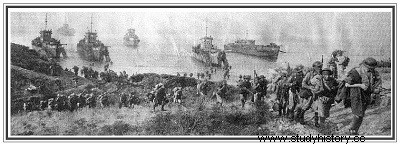
Few campaigns of the Second World War gave rise to such bitter discussions as Operation "Dragoon", the Allied landings in Provence on August 15, 1944. First called "Anvil", this operation was ardently supported by the Americans - the President Franklin D. Roosevelt and General Dwight D. Eisenhower in the lead — as an indispensable complement to Operation “Overlord” (the Normandy landings). "Anvil" and "Overlord" were scheduled for the same day in early summer 1944 at the Tehran and Cairo conferences (November-December 1943). They consisted of taking the German forces in France in a pincer movement along a north-south axis. The French and the British approved of the principle of the pincer movement, but disputed the idea that Provence was the best place to apply the southern jaw.
The greatest fear of those who, like Churchill, criticizing a landing in Provence was that the Anglo-American war effort in Europe was going too far west. This landing operation baptized "Anvil" then "Dragoon" meant:leaving a free hand to the Soviets whose forces exerted their pressure on Germany from the east, and who could thus impose their will on the greater part of the Post-war Europe.
An offensive in the Balkans, through Albania and Greece and from there to Yugoslavia and Austria, would have averted this dangerous possibility. . The same was true, one might think, of a breakthrough in Italy towards southeastern France or southern Austria and Germany. The purely Italian approach also offered the advantage of not reducing the Allied forces then engaged in a slow and costly advance towards the north of the peninsula, and of giving them a chance to end this campaign.
Neither Roosevelt nor Einsenhower saw things in this light. They seemed totally absorbed in “Overlord” and its success. From this perspective, an invasion of the South of France could be an essential guarantee of success insofar as it offered better guarantees than an operation in Italy, in the Balkans or on the coasts of Brittany - another alternative proposed by the detractors. of "Anvil". The presence of sizable Allied forces in Provence guaranteed Eisenhower access to deep-water ports, the possibility of rapid rescue in the event the Normandy forces were trapped, and the opportunity to weaken German resistance to the push of "Overlord" by dividing the enemy forces on two separate fronts.
Churchill had not been convinced by these arguments. At the end of 1944, he was still trying to get the Americans to change their minds. Operation “Overdord” was started on June 6. "Anvil" had not accompanied it as originally planned, partly for lack of landing craft, but mainly because it had been necessary to wait for the 3' and 45' American divisions, encircled in the bridgehead of Anzio, near Rome, managed to break the German embrace and join the Allied 3rd Army.
The Allied advance into Normandy slowed after D-Day. June 23, she found herself behind the forecasts. This delay prompted. Americans to talk about “Anvil” again with increased insistence. Rather than engage in a stalemate with his powerful ally, Churchill bowed and agreed to what he called "a dull and fruitless undertaking".
On July 2, General Sir Henry Maitlan Wilson (Commander in Chief for the Mediterranean) received the order to organize a landing in Provence for August 15. This operation can no longer be considered as the "anvil" (An vile) of the "hammer" striking in Normandie the code name of the operation was changed:by Churchill to "Dragoon".
Most of the operations d; landing by sea was to be carried out:by the 3', 36' and 45' divisions of the VII American army, under the command of General Alexander M. Patch, reinforced p. the French 2nd Army Corps. Air Brigadier General P. Saville (Commander 1 12' Tactical Air Force) was given command of air operations. Naval operations were placed under Admiral Sir Jo H.D. Cunningham of the Royal Navy.
US Vice-Admiral Henry K. Hewitt was in command of the Naval Task Force. Seven divisions of General de Lattre de Tassigny's 1st Army would also have to take part in the action.
Compared to the perilous and often tragic episodes experienced during previous landings in North Africa , in Sicily and Italy, this operation planned on a 55 kilometer front, between Cavalaire and Agay, presented itself as a relatively simple affair.The Allies had learned the difficult lessons learned during the previous experiences, in particular with regard to the crucial role played by air forces in amphibious operations.
